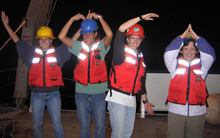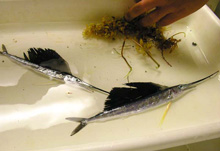
The Night Crew: (left to right) Jennie McCLain, Tara Casazza (watch chief), Barb Lubinski and Reneé Green. Click image for larger view and image credit.
From Dusk to Dawn
October 22, 2005
Barb Lubinski
Biologist
U.S. Geological Survey
Leetown Science Center
The first night was the hardest.
Starting the day at 7:00 AM to load the vehicles and hit the road didn't help. By the time we unloaded and organized the equipment and cabins, it was 5:00 PM and I was ready for bed.
Unfortunately, I am part of the night crew and my work had only just begun. It was no fun watching everyone else slowly disappear below decks leaving us night crew girls by ourselves. (The ship's crew of course was still around). We spent most of the night putting out the Neuston net for 15-minute surface tows. Once the net was retrieved, we removed the sample to see what we caught. Sargassum, filefish, sailfish, lanternfish, Sargassum fish, flyingfish, halfbeaks, and eel larvae were some of the many organisms we caught. We repeated this for hours and hours and before long it was a struggle to stay awake. At 4:00 AM we started sonar transects and sat at a computer looking at the bottom relief. By 6:00 AM, Jennie McClain and I were dozing in front of the computer screen watching the sonar waves slowing reveal the ocean bottom in hopes of finding potential dive sites. After being up for almost 24 hours, I was too tired to stay up for breakfast and happy to just crawl into my bunk and sleep.
Jennie and I also discovered the key to staying up all night: constantly eating. The galley is always open and there is much to choose from: tea, coffee, hot chocolate, toast, bagels, yogurt, leftovers from dinner, crackers, cookies, candy, raisins, pop tarts, granola bars, and even ice cream! (Lucky for us, there is just enough time between tows for a small snack or drink.) We again stopped our tows around 4:00 AM and started the sonar. This time we managed to stay awake through it all, and I even stayed up for breakfast. Sleep came easily after a hard night's work and a full stomach.
Night three was almost the same as the first two, except the wind picked up, creating rougher seas. Luckily, we had foul weather gear which Jennie graciously modeled on the "runway" for the camera.
Now it is fun after a full night of work to watch everyone else emerge for breakfast and to join in on the yawning. I've become a true night owl and eat breakfast for dinner, dinner for breakfast, watch the sunset instead of sunrise, sleep during the day and work all night – it's not a bad life, at least for a couple of weeks!
Life on the Edge will be sending daily reports from Oct 16 - Nov 4. Please check back frequently for additional logs from this expedition.


























